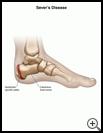
Sever’s Disease of the Heel (Calcaneal Apophysitis)
________________________________________________________________________
KEY POINTS
- Sever’s disease is a painful irritation of the growth plate in the heel bone. It is caused by running on hard surfaces, wearing shoes that do not fit properly, or having tight muscles and tendons.
- Your child may need to change or stop doing the activities that cause pain until the bone heals. Your child may need to do foot and leg exercises to stretch and strengthen the leg muscles and tendons.
- The best way to prevent Sever’s disease is to make sure that your child wears shoes that fit properly. Also, make sure that your child doesn't play on too many teams or practice for too long. Also, make sure your child stretches properly before activities.
________________________________________________________________________
What is Sever’s disease?
Sever’s disease is a painful irritation of the growth plate in the heel bone. It is the most common cause of heel pain in children and teens.
Sever’s disease is also called calcaneal apophysitis.
What is the cause?
Your child’s heel bone keeps forming new bone until the late teens. The new bone is weak and can be damaged by running or pounding on hard surfaces, like during a basketball game. The new bone may also be irritated by shoes with poor padding in the heels or poor arch supports. Tight muscles and tendons can also put pressure on the areas of new bone.
What are the symptoms?
Your child’s heel hurts. It may hurt as soon as he or she gets out of bed. Running and jumping usually make the heel hurt more. Your child may walk on his or her toes to keep the heel from hurting.
How is it diagnosed?
Your child’s healthcare provider will ask about your child’s symptoms, medical history, and activities and examine your child. Tests may include X-rays or other scans.
How is it treated?
Your child may need to change or stop doing the activities that cause pain until the growth plate heals.
Your child needs to wear shoes with good padding in the heels and good arch support. Special shoes or shoe inserts may help. Your child may need to do foot and leg exercises to stretch and strengthen the leg muscles and tendons.
Pain from Sever’s disease may last weeks to months. The pain may come back if your child returns to sports or strenuous activities too soon.
How can I take care of my child?
- To help relieve pain, give your child nonprescription pain medicine such as acetaminophen, ibuprofen, or naproxen. Read the label carefully and give your child the correct dose as directed.
- Nonsteroidal anti-inflammatory medicines (NSAIDs) such as ibuprofen, naproxen, and aspirin, may cause stomach bleeding and other problems. Check with your healthcare provider before you give any medicine that contains aspirin or salicylates to a child or teen. This includes medicines like baby aspirin, some cold medicines, and Pepto-Bismol. Children and teens who take aspirin are at risk for a serious illness called Reye syndrome.
- Acetaminophen may cause liver damage or other problems. Do not give more doses than directed. To make sure you don’t give your child too much, check other medicines your child takes to see if they also contain acetaminophen. Unless recommended by your healthcare provider, your child should not take this medicine for more than 5 days.
Ask your child’s healthcare provider:
- How and when you will get your child’s test results
- How long it will take for your child to recover
- If there are activities your child should avoid and when your child can return to normal activities
- How to take care of your child at home
- What symptoms or problems you should watch for and what to do if your child has them
Make sure you know when your child should come back for a checkup.
How can I help prevent Sever’s disease?
The best way to prevent Sever’s disease is to make sure that your child wears shoes that fit properly. The heel portion of the shoe should not be too tight, and there should be good padding in the heel. It may help to put extra heel pads in your child's shoes. Stretching before exercise also helps.
Some children simply get too much physical activity. For example, they may play on too many teams or practice for too long. Their heel pain is a message to slow down.
Last modified: 2022-02-07
Last reviewed: 2019-04-28

